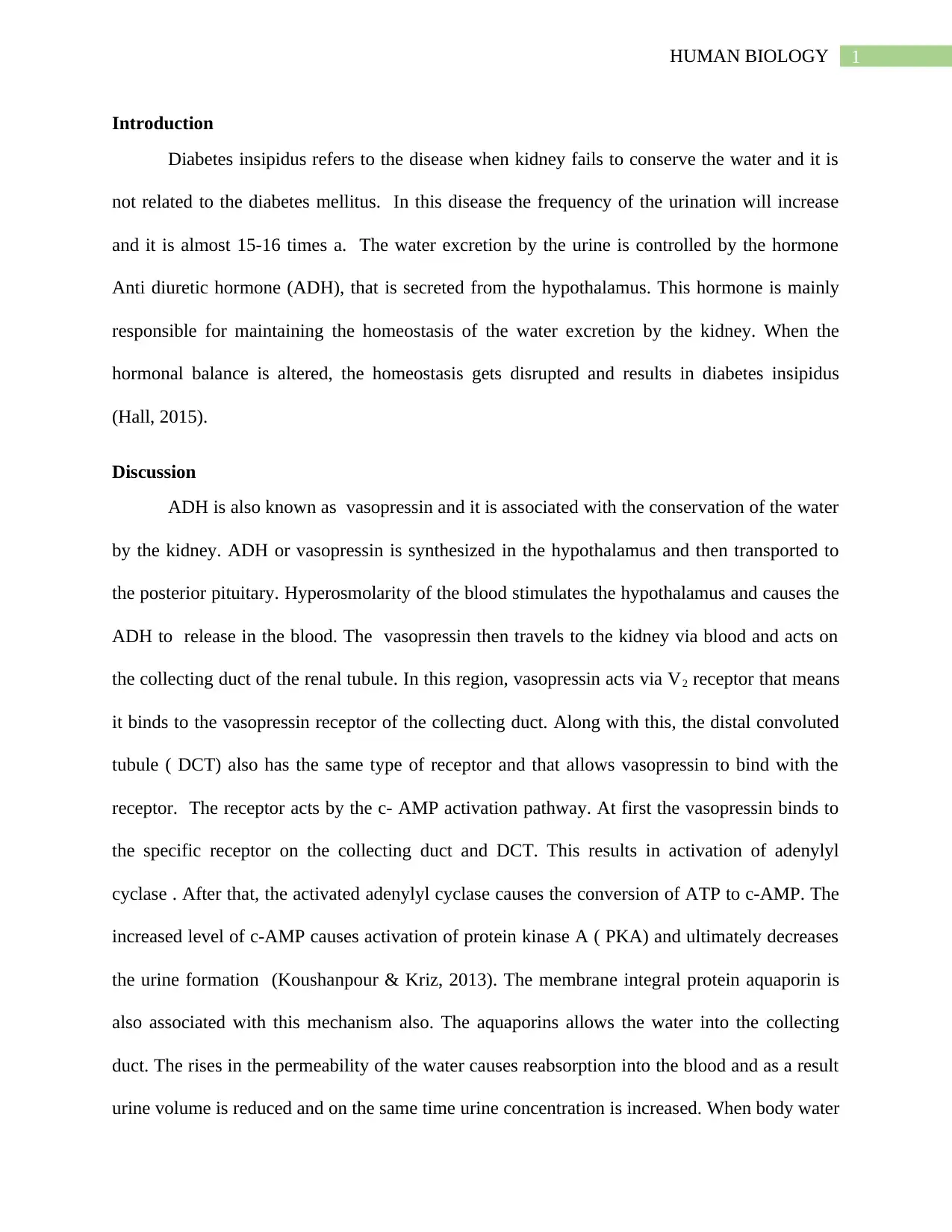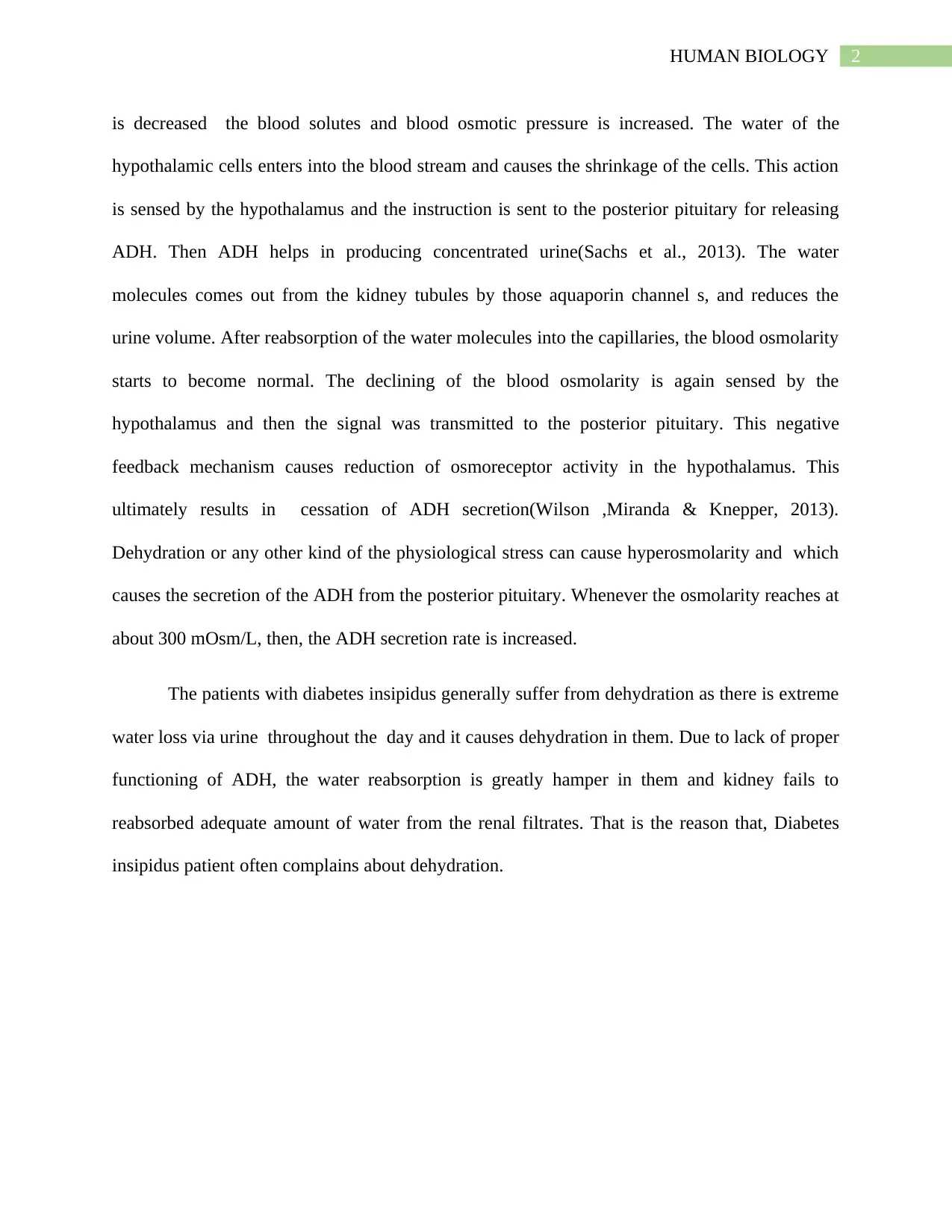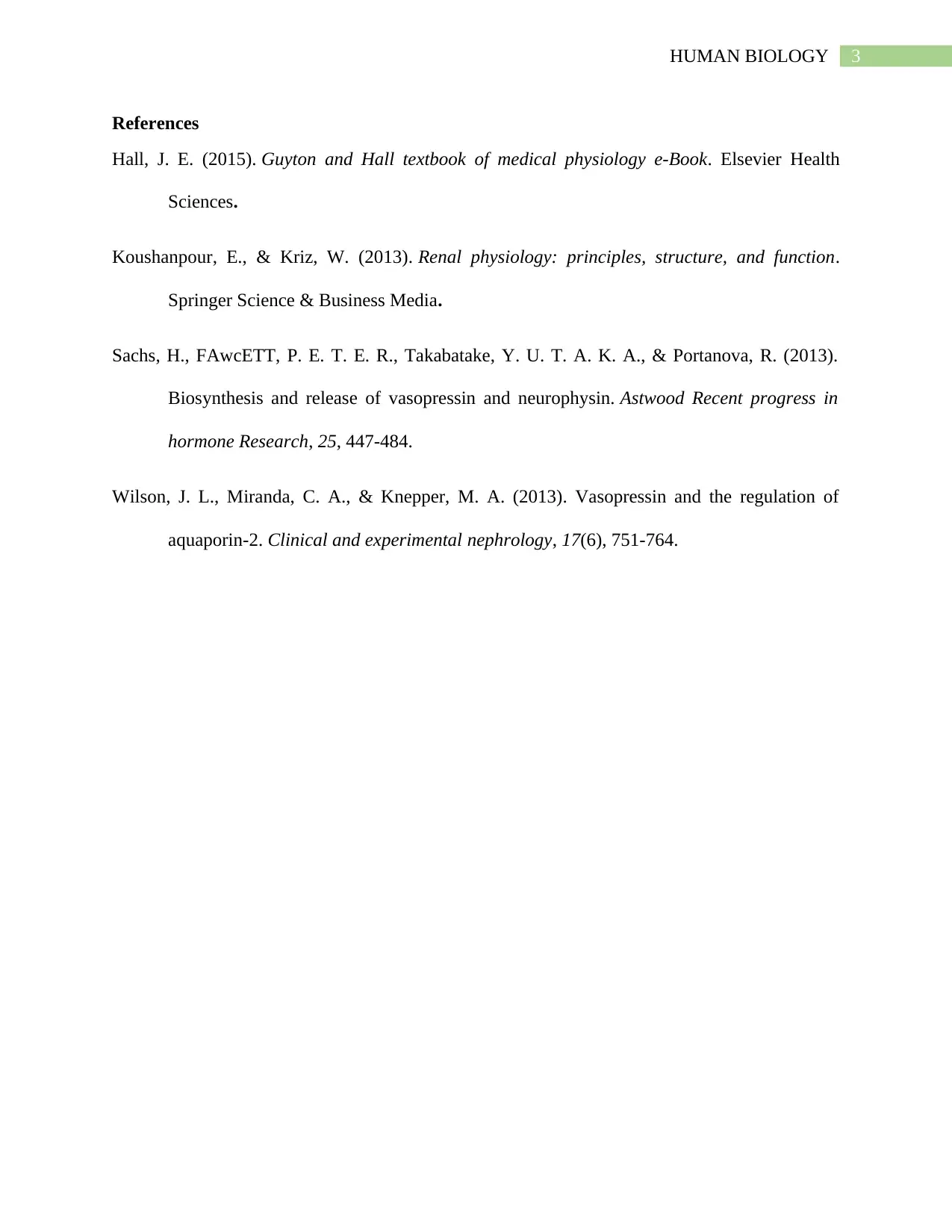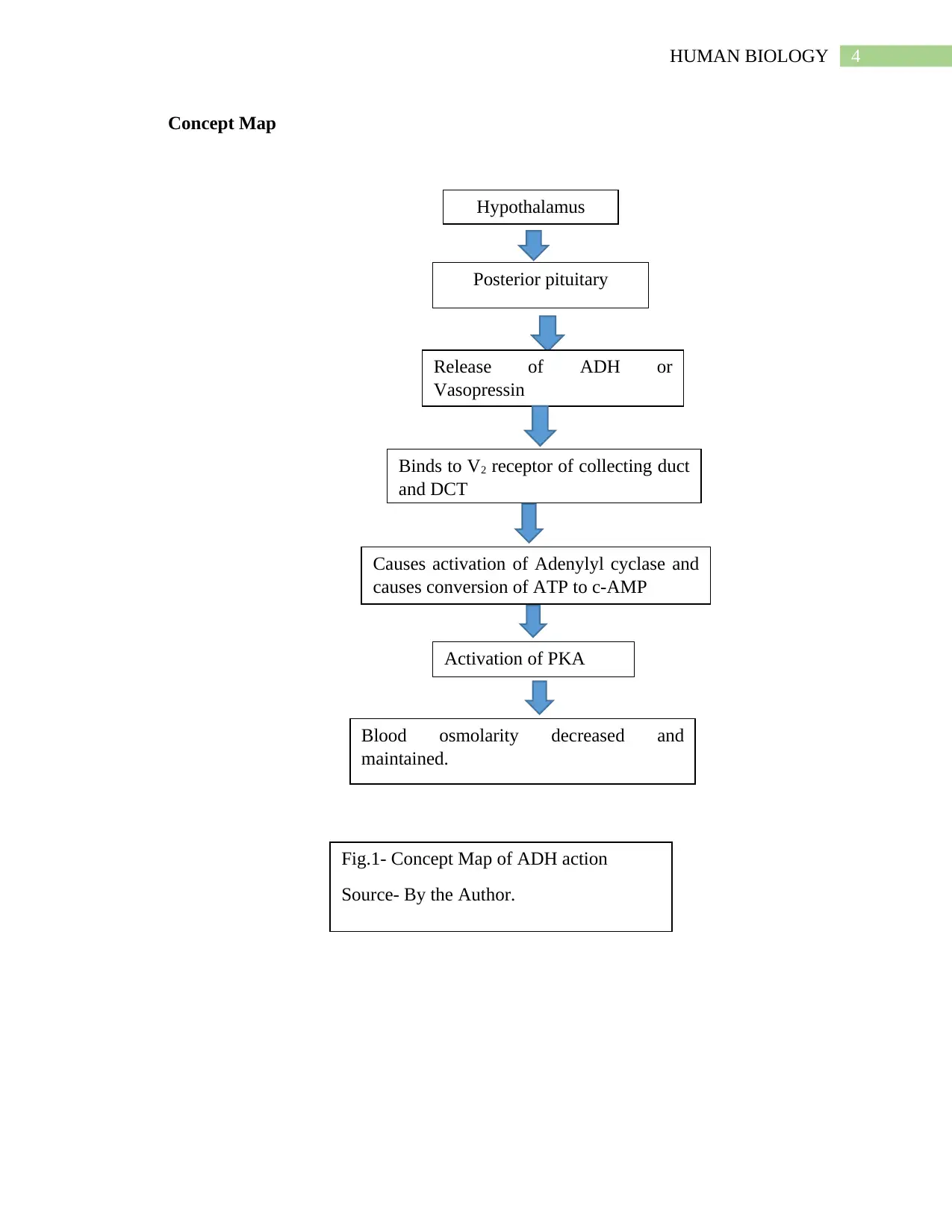The Role of ADH in Water Conservation and Diabetes Insipidus
VerifiedAdded on 2023/06/08
|5
|856
|326
Report
AI Summary
This report discusses diabetes insipidus, a condition where the kidneys fail to conserve water, and its connection to the Anti-Diuretic Hormone (ADH), also known as vasopressin. ADH, synthesized in the hypothalamus and released by the posterior pituitary, plays a crucial role in maintaining water homeostasis by acting on the collecting ducts of the renal tubules via V2 receptors, activating the c-AMP pathway, and influencing aquaporin activity to regulate water reabsorption. The report details the mechanism of ADH action, including its response to blood osmolarity and the negative feedback loop that controls its secretion. Patients with diabetes insipidus often suffer from dehydration due to impaired ADH function, leading to excessive water loss through urine. A concept map illustrates the ADH pathway, highlighting the key steps in water balance regulation.

Running head : HUAMN BIOLOGY
Human Biology
Name of the Student
Name of the University
Author Note
Human Biology
Name of the Student
Name of the University
Author Note
Paraphrase This Document
Need a fresh take? Get an instant paraphrase of this document with our AI Paraphraser

1HUMAN BIOLOGY
Introduction
Diabetes insipidus refers to the disease when kidney fails to conserve the water and it is
not related to the diabetes mellitus. In this disease the frequency of the urination will increase
and it is almost 15-16 times a. The water excretion by the urine is controlled by the hormone
Anti diuretic hormone (ADH), that is secreted from the hypothalamus. This hormone is mainly
responsible for maintaining the homeostasis of the water excretion by the kidney. When the
hormonal balance is altered, the homeostasis gets disrupted and results in diabetes insipidus
(Hall, 2015).
Discussion
ADH is also known as vasopressin and it is associated with the conservation of the water
by the kidney. ADH or vasopressin is synthesized in the hypothalamus and then transported to
the posterior pituitary. Hyperosmolarity of the blood stimulates the hypothalamus and causes the
ADH to release in the blood. The vasopressin then travels to the kidney via blood and acts on
the collecting duct of the renal tubule. In this region, vasopressin acts via V2 receptor that means
it binds to the vasopressin receptor of the collecting duct. Along with this, the distal convoluted
tubule ( DCT) also has the same type of receptor and that allows vasopressin to bind with the
receptor. The receptor acts by the c- AMP activation pathway. At first the vasopressin binds to
the specific receptor on the collecting duct and DCT. This results in activation of adenylyl
cyclase . After that, the activated adenylyl cyclase causes the conversion of ATP to c-AMP. The
increased level of c-AMP causes activation of protein kinase A ( PKA) and ultimately decreases
the urine formation (Koushanpour & Kriz, 2013). The membrane integral protein aquaporin is
also associated with this mechanism also. The aquaporins allows the water into the collecting
duct. The rises in the permeability of the water causes reabsorption into the blood and as a result
urine volume is reduced and on the same time urine concentration is increased. When body water
Introduction
Diabetes insipidus refers to the disease when kidney fails to conserve the water and it is
not related to the diabetes mellitus. In this disease the frequency of the urination will increase
and it is almost 15-16 times a. The water excretion by the urine is controlled by the hormone
Anti diuretic hormone (ADH), that is secreted from the hypothalamus. This hormone is mainly
responsible for maintaining the homeostasis of the water excretion by the kidney. When the
hormonal balance is altered, the homeostasis gets disrupted and results in diabetes insipidus
(Hall, 2015).
Discussion
ADH is also known as vasopressin and it is associated with the conservation of the water
by the kidney. ADH or vasopressin is synthesized in the hypothalamus and then transported to
the posterior pituitary. Hyperosmolarity of the blood stimulates the hypothalamus and causes the
ADH to release in the blood. The vasopressin then travels to the kidney via blood and acts on
the collecting duct of the renal tubule. In this region, vasopressin acts via V2 receptor that means
it binds to the vasopressin receptor of the collecting duct. Along with this, the distal convoluted
tubule ( DCT) also has the same type of receptor and that allows vasopressin to bind with the
receptor. The receptor acts by the c- AMP activation pathway. At first the vasopressin binds to
the specific receptor on the collecting duct and DCT. This results in activation of adenylyl
cyclase . After that, the activated adenylyl cyclase causes the conversion of ATP to c-AMP. The
increased level of c-AMP causes activation of protein kinase A ( PKA) and ultimately decreases
the urine formation (Koushanpour & Kriz, 2013). The membrane integral protein aquaporin is
also associated with this mechanism also. The aquaporins allows the water into the collecting
duct. The rises in the permeability of the water causes reabsorption into the blood and as a result
urine volume is reduced and on the same time urine concentration is increased. When body water

2HUMAN BIOLOGY
is decreased the blood solutes and blood osmotic pressure is increased. The water of the
hypothalamic cells enters into the blood stream and causes the shrinkage of the cells. This action
is sensed by the hypothalamus and the instruction is sent to the posterior pituitary for releasing
ADH. Then ADH helps in producing concentrated urine(Sachs et al., 2013). The water
molecules comes out from the kidney tubules by those aquaporin channel s, and reduces the
urine volume. After reabsorption of the water molecules into the capillaries, the blood osmolarity
starts to become normal. The declining of the blood osmolarity is again sensed by the
hypothalamus and then the signal was transmitted to the posterior pituitary. This negative
feedback mechanism causes reduction of osmoreceptor activity in the hypothalamus. This
ultimately results in cessation of ADH secretion(Wilson ,Miranda & Knepper, 2013).
Dehydration or any other kind of the physiological stress can cause hyperosmolarity and which
causes the secretion of the ADH from the posterior pituitary. Whenever the osmolarity reaches at
about 300 mOsm/L, then, the ADH secretion rate is increased.
The patients with diabetes insipidus generally suffer from dehydration as there is extreme
water loss via urine throughout the day and it causes dehydration in them. Due to lack of proper
functioning of ADH, the water reabsorption is greatly hamper in them and kidney fails to
reabsorbed adequate amount of water from the renal filtrates. That is the reason that, Diabetes
insipidus patient often complains about dehydration.
is decreased the blood solutes and blood osmotic pressure is increased. The water of the
hypothalamic cells enters into the blood stream and causes the shrinkage of the cells. This action
is sensed by the hypothalamus and the instruction is sent to the posterior pituitary for releasing
ADH. Then ADH helps in producing concentrated urine(Sachs et al., 2013). The water
molecules comes out from the kidney tubules by those aquaporin channel s, and reduces the
urine volume. After reabsorption of the water molecules into the capillaries, the blood osmolarity
starts to become normal. The declining of the blood osmolarity is again sensed by the
hypothalamus and then the signal was transmitted to the posterior pituitary. This negative
feedback mechanism causes reduction of osmoreceptor activity in the hypothalamus. This
ultimately results in cessation of ADH secretion(Wilson ,Miranda & Knepper, 2013).
Dehydration or any other kind of the physiological stress can cause hyperosmolarity and which
causes the secretion of the ADH from the posterior pituitary. Whenever the osmolarity reaches at
about 300 mOsm/L, then, the ADH secretion rate is increased.
The patients with diabetes insipidus generally suffer from dehydration as there is extreme
water loss via urine throughout the day and it causes dehydration in them. Due to lack of proper
functioning of ADH, the water reabsorption is greatly hamper in them and kidney fails to
reabsorbed adequate amount of water from the renal filtrates. That is the reason that, Diabetes
insipidus patient often complains about dehydration.
⊘ This is a preview!⊘
Do you want full access?
Subscribe today to unlock all pages.

Trusted by 1+ million students worldwide

3HUMAN BIOLOGY
References
Hall, J. E. (2015). Guyton and Hall textbook of medical physiology e-Book. Elsevier Health
Sciences.
Koushanpour, E., & Kriz, W. (2013). Renal physiology: principles, structure, and function.
Springer Science & Business Media.
Sachs, H., FAwcETT, P. E. T. E. R., Takabatake, Y. U. T. A. K. A., & Portanova, R. (2013).
Biosynthesis and release of vasopressin and neurophysin. Astwood Recent progress in
hormone Research, 25, 447-484.
Wilson, J. L., Miranda, C. A., & Knepper, M. A. (2013). Vasopressin and the regulation of
aquaporin-2. Clinical and experimental nephrology, 17(6), 751-764.
References
Hall, J. E. (2015). Guyton and Hall textbook of medical physiology e-Book. Elsevier Health
Sciences.
Koushanpour, E., & Kriz, W. (2013). Renal physiology: principles, structure, and function.
Springer Science & Business Media.
Sachs, H., FAwcETT, P. E. T. E. R., Takabatake, Y. U. T. A. K. A., & Portanova, R. (2013).
Biosynthesis and release of vasopressin and neurophysin. Astwood Recent progress in
hormone Research, 25, 447-484.
Wilson, J. L., Miranda, C. A., & Knepper, M. A. (2013). Vasopressin and the regulation of
aquaporin-2. Clinical and experimental nephrology, 17(6), 751-764.
Paraphrase This Document
Need a fresh take? Get an instant paraphrase of this document with our AI Paraphraser

4HUMAN BIOLOGY
Concept Map
Hypothalamus
Posterior pituitary
Release of ADH or
Vasopressin
Binds to V2 receptor of collecting duct
and DCT
Causes activation of Adenylyl cyclase and
causes conversion of ATP to c-AMP
Activation of PKA
Blood osmolarity decreased and
maintained.
Fig.1- Concept Map of ADH action
Source- By the Author.
Concept Map
Hypothalamus
Posterior pituitary
Release of ADH or
Vasopressin
Binds to V2 receptor of collecting duct
and DCT
Causes activation of Adenylyl cyclase and
causes conversion of ATP to c-AMP
Activation of PKA
Blood osmolarity decreased and
maintained.
Fig.1- Concept Map of ADH action
Source- By the Author.
1 out of 5
Related Documents
Your All-in-One AI-Powered Toolkit for Academic Success.
+13062052269
info@desklib.com
Available 24*7 on WhatsApp / Email
![[object Object]](/_next/static/media/star-bottom.7253800d.svg)
Unlock your academic potential
Copyright © 2020–2025 A2Z Services. All Rights Reserved. Developed and managed by ZUCOL.





